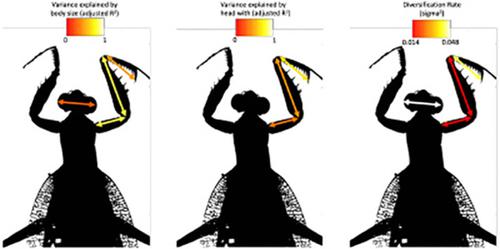当前位置:
X-MOL 学术
›
J. Morphol.
›
论文详情
Our official English website, www.x-mol.net, welcomes your feedback! (Note: you will need to create a separate account there.)
Evolutionary diversification in the raptorial forelegs of Mantodea: Relations to body size and depth perception
Journal of Morphology ( IF 1.5 ) Pub Date : 2020-03-27 , DOI: 10.1002/jmor.21118 Christopher E Oufiero 1
Journal of Morphology ( IF 1.5 ) Pub Date : 2020-03-27 , DOI: 10.1002/jmor.21118 Christopher E Oufiero 1
Affiliation

|
Limb proportions have evolved among animals to meet functional demands among diverse environments. Studies from terrestrial, vertebrate locomotion have demonstrated that variation in limb proportions have adaptively evolved so animals can perform in a given environment. Most of the research on limb proportion evolution is among vertebrates and terrestrial locomotion, with little information on limb segment evolution in invertebrates or for other functional roles. For example, among invertebrates, multisegmented raptorial forelimbs have evolved multiple times independently to capture prey, but there is little information on the adaptive evolution and diversity of these limbs. Furthermore, as feeding performance is influenced by the sensory system, few studies have examined the coevolution of sensory‐motor systems. Using mantises (Mantodea) I examined forelimb diversification among 97 species with a combination of methods, including ternary plots for morphospace visualization, phylogenetically informed allometric relationships, and comparison of evolutionary rates of diversification. Furthermore, using head width as a proxy for depth perception, I examined the correlated evolution of foreleg diversity with depth perception. The results show that among the three segments of the foreleg, the tibia is the smallest, most diverse, and has the highest rate of evolution after body size corrections. Furthermore, while all foreleg segments were related to head width, head width explained the most variation in tibial length compared with other foreleg segments. The results suggest a potential adaptive functional role of tibia length related to the displacement or force produced in this mechanical lever. Furthermore, results from this study support distinct ecomorphs of mantises, as several independent evolutions to grass mimicry evolve similar morphologies.
中文翻译:

Mantodea 猛禽前腿的进化多样化:与体型和深度知觉的关系
动物的肢体比例已经进化,以满足不同环境中的功能需求。陆地、脊椎动物运动的研究表明,肢体比例的变化已经适应性进化,因此动物可以在给定的环境中表现。大多数关于肢体比例进化的研究是在脊椎动物和陆地运动之间进行的,关于无脊椎动物肢体节段进化或其他功能作用的信息很少。例如,在无脊椎动物中,多节的猛禽前肢独立进化了多次以捕获猎物,但关于这些肢的适应性进化和多样性的信息很少。此外,由于进食性能受感觉系统的影响,很少有研究检查感觉-运动系统的协同进化。使用螳螂 (Mantodea),我使用多种方法检查了 97 种物种的前肢多样化,包括用于形态空间可视化的三元图、系统发育通知的异速生长关系以及多样化进化速率的比较。此外,使用头部宽度作为深度感知的代理,我检查了前腿多样性与深度感知的相关演变。结果表明,在前腿的三个节段中,胫骨是最小的,最多样化的,在体型校正后的进化率最高。此外,虽然所有前腿节段都与头部宽度有关,但与其他前腿节段相比,头部宽度解释了胫骨长度的最大变化。结果表明胫骨长度的潜在适应性功能作用与该机械杠杆中产生的位移或力有关。此外,这项研究的结果支持螳螂的不同生态形态,因为草拟态的几个独立进化进化出相似的形态。
更新日期:2020-03-27
中文翻译:

Mantodea 猛禽前腿的进化多样化:与体型和深度知觉的关系
动物的肢体比例已经进化,以满足不同环境中的功能需求。陆地、脊椎动物运动的研究表明,肢体比例的变化已经适应性进化,因此动物可以在给定的环境中表现。大多数关于肢体比例进化的研究是在脊椎动物和陆地运动之间进行的,关于无脊椎动物肢体节段进化或其他功能作用的信息很少。例如,在无脊椎动物中,多节的猛禽前肢独立进化了多次以捕获猎物,但关于这些肢的适应性进化和多样性的信息很少。此外,由于进食性能受感觉系统的影响,很少有研究检查感觉-运动系统的协同进化。使用螳螂 (Mantodea),我使用多种方法检查了 97 种物种的前肢多样化,包括用于形态空间可视化的三元图、系统发育通知的异速生长关系以及多样化进化速率的比较。此外,使用头部宽度作为深度感知的代理,我检查了前腿多样性与深度感知的相关演变。结果表明,在前腿的三个节段中,胫骨是最小的,最多样化的,在体型校正后的进化率最高。此外,虽然所有前腿节段都与头部宽度有关,但与其他前腿节段相比,头部宽度解释了胫骨长度的最大变化。结果表明胫骨长度的潜在适应性功能作用与该机械杠杆中产生的位移或力有关。此外,这项研究的结果支持螳螂的不同生态形态,因为草拟态的几个独立进化进化出相似的形态。


























 京公网安备 11010802027423号
京公网安备 11010802027423号